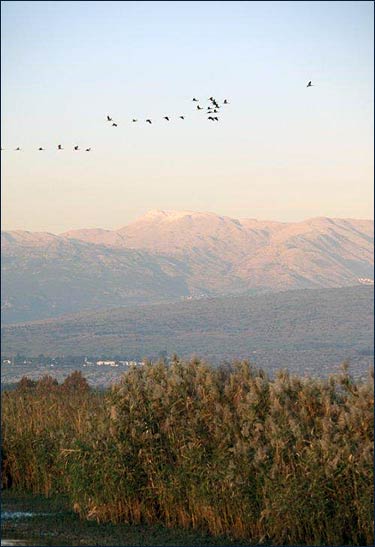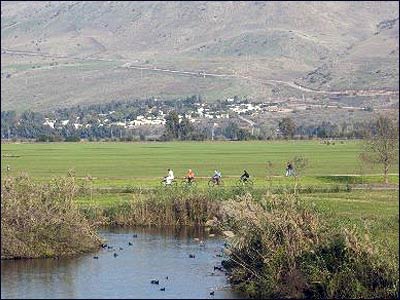Prior to the establishment of the State of Israel, The Hula Lake and the surrounding wetlands were a natural environment unique not only to the Land of Israel but to the entire Middle East. This distinction was due in no small part to the wide variety of fauna and flora found in the region, representative of many different international climate zones.
The Hula Lake is situated in Israel's Galilee Panhandle, not far from the border with Lebanon and Syria. The Hula Nature Reserve was the first nature reserve established in Israel, and the public battle for its establishment was instrumental in the creation of the Society for the Protection of Nature in Israel.
Prior to the establishment of the state, the Hula Lake was a disease-infested swamp. The campaign to drain the swamps was initiated in 1951, when many naturalists were recruited to ensure that part of the natural environment would remain as it was for research and demonstrative purposes. The remaining reclaimed land was turned to agricultural purposes. In 1971 it was decided to attempt to restore the reserve, mainly by renovating the embankment and the construction of a sedimentation reservoir to improve the quality of the water.
 Cranes over the Hula LakePhoto: Itamar Grinberg/Ministry of Tourism
Cranes over the Hula LakePhoto: Itamar Grinberg/Ministry of TourismThe preservation of the Hula Lake allows tens of thousands of birds – including cranes, storks, pelicans, cormorants and herons - to reside in the reserve. More than 200 species of waterfowl have come to recognize the advantages of the reserve, and they flock here in droves. The reserve also serves as a refuge for rare water plants. Buffalo grazing areas have been designated here as well, to preserve the features of the natural open pasture.
The reserve is also responsible the reintroduction of certain virtually extinct bird species to nature. One example of this is the reintroduction the White-tailed eagle.
Walking trails have been established as well, some in the form of floating bridges over the marsh, and bird-observation sites have also been constructed. The main path through the reservation has been adapted for handicapped visitors on wheelchairs.
The Oforia Visitors’ Center
Many changes and improvements have been made since the establishment of the reserve. The recently opened Oforia Visitors’ Center is one example. The tour begins with a model of the Hula Valley, after which a video explaining the formation of the Hula Valley and the draining of the lake and marshes is screened. Then, two dioramas create a three-dimensional effect depicting the birds and mammals of the Hula Valley.
 Biking in the Hula Nature ReservePhoto: Itamar Grinberg/Ministry of Tourism
Biking in the Hula Nature ReservePhoto: Itamar Grinberg/Ministry of TourismThe next stage is the real heart of the matter: an elaborate 3-D multimedia show that is intended to be viewed using special eyeglasses that provide a three-dimensional sensation. For 15 minutes, viewers feel as if they have joined a flock of migratory birds, instantly becoming one of them. The visit ends with a computerized trivia quiz about the Hula Nature Reserve.